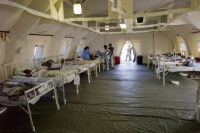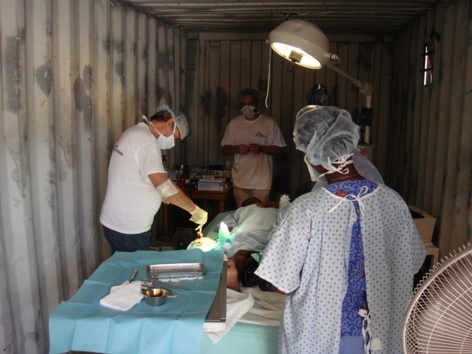Picture the scene: a 7.0 magnitude earthquake strikes in one of the poorest countries in the world. Less than a minute later, hundreds of thousands of buildings have collapsed. Vital infrastructure is in ruins. Countless lives have been lost. Dust and debris hangs in the air, coating everything in sight.
Your task as a humanitarian engineer? To enable surgeons to save lives by providing a space in which they can perform amputations, treat fractures, reconstruct crushed limbs and tend to head, face and brain injuries.
This was my challenge almost exactly two years ago in Port-au-Prince, Haiti, after the devastating 2010 quake. It is a situation that will have faced many other disaster relief engineers this year, to a greater or lesser extent, in Japan, Turkey, Burma, China and New Zealand – to name but a few.
But how do medical staff operate on injured people when, as in Haiti, many of the hospitals have been badly damaged or, in some cases, destroyed altogether? The answer is field surgery, with a difference.
The first thing you need is somewhere to work. It has to be sterile. It has to have a water supply. It needs to be wired up to a generator. And you need to be able to start using it quickly, usually within a matter of days.
Rather than building an entirely new facility – which could take months in a disaster zone – today, major aid organisations simply bring their own.
The ‘inflatable hospital’ is a real feat of humanitarian engineering, with space for up to 180 patients, an operating theatre, a recovery unit, specially adapted cooling and heating systems, wash basins, a water supply and detachable tent ‘modules’ which can be added or removed as needed.

In Haiti, this incredible facility – which takes just 48 hours to ‘pump’ up – was used to treat thousands of injuries and perform surgical procedures which saved many lives.
Remarkable though they are, sometimes even inflatable hospitals aren’t quite the solution we need. They can take up lots of room – up to 100sqm (not easy to come by in a disaster-hit city), they can be slow to arrive from storage, and they cost a fortune – about $500,000 each!
Over the years, my colleagues and I have learnt some very valuable lessons about field surgery, and we’ve come up with a few more engineering solutions to help meet the needs of the health professionals who lead emergency responses around the world.
Here’s one of them: the shipping container operating theatre. While waiting for inflatable hospitals to arrive – and also to reduce the risk of contamination from earthquake dust – we often fashion emergency operating theatres from these large, steel crates. Not only are they fairly easy to get hold of and relatively cheap, but they are small enough to squeeze into an urban area which has been badly damaged.

Initially, we used this idea during the Kosovo crisis, where shipping containers enabled us to quickly set up emergency hospitals and health centres and keep people out of the cold. In Haiti, this same solution helped us to carry out more than 25 operations a day in the early response phase.
Now, we are already working on another initiative: adapting plastic altitude chambers (just like the ones used by sports stars to acclimatise to new environmental conditions) to help seal entries and exits to makeshift operating theatres in the field.
There are many advantages. The air-tight plastic structures are smaller and cheaper than inflatable field hospitals – and will enable us to control the sterilisation of an enclosed area more quickly and effectively than we are currently able to.
We will shortly pilot this new tool in the Central African Republic and, if successful, the plastic chamber (as yet without a name) will likely become part of our kit, ready for the next emergency.
Our creations are not always perfect. Sometimes, they are born of necessity rather than lengthy research and development. But, in a field situation where lives are at risk, simple solutions can work just as well as the multi-million pound, state-of-the-art medical facilities we have come to expect at home.
For more about RedR, including how to get involved and donate, please visit the website.
![]()





Swiss geoengineering start-up targets methane removal
No mention whatsoever about the effect of increased methane levels/iron chloride in the ocean on the pH and chemical properties of the ocean - are we...